by Eric Meier
When attempting to identify a wood sample, it’s important to keep in mind the limitations and obstacles that are present in our task. Before starting, please have a look at The Truth Behind Wood Identification to approach the task in a proper mindset; I consider the linked article to be required reading for all those visiting my site with the intent of identifying wood.
1. Confirm it is actually solid wood.
Before proceeding too much farther into the remaining steps, it’s first necessary to confirm that the material in question is actually a solid piece of wood, and not a man-made composite or piece of plastic made to imitate wood.
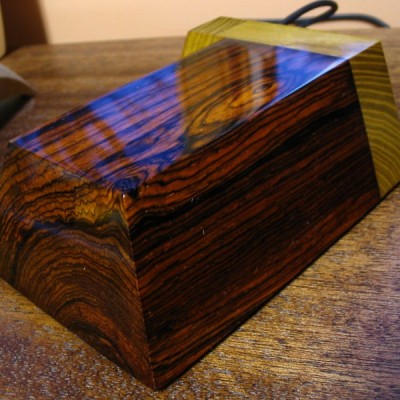
Can you see the end-grain?
Manufactured wood such as MDF, OSB, and particleboard all have a distinct look that is—in nearly all cases—easily distinguishable from the endgrain of real wood. Look for growth rings—formed by the yearly growth of a tree—which will be a dead-giveaway that the wood sample in question is a solid, genuine chunk of wood taken from a tree.
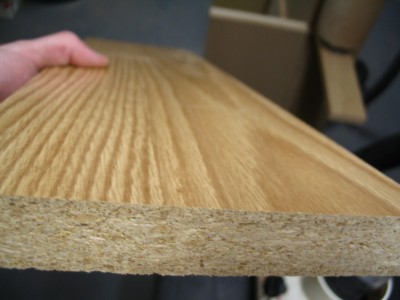
Is it veneered?
If you see a large panel that has a repeating grain pattern, it may be a veneer. In such cases, a very thin layer of real wood is peeled from a tree and attached to a substrate; sometimes the veneer can be one continuous repeating piece because it is rotary-sliced to shave off the veneer layer as the tree trunk is spun by machines. Assuming it is a real wood veneer with a distinct grain and texture—and not merely a piece of printed plastic—you may still be able to identify the outer veneer wood in question, but you should still realize that is it only a veneer and not a solid piece of wood.
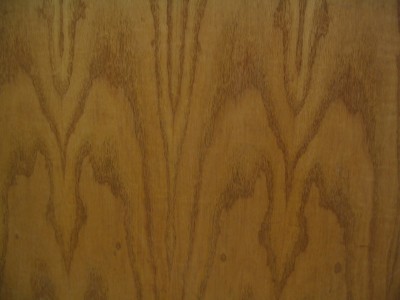
Is it painted or printed to look like wood?
Many times, especially on medium to large-sized flat panels for furniture, a piece of particleboard or MDF is either laminated with a piece of wood-colored plastic, or simply painted to look like wood grain. Many of today’s interior hardwood flooring planks are good examples of these pseudo-wood products: they are essentially a man-made material made of sawdust, glues, resins, and durable plastics.
2. Look at the color.
Some questions to immediately ask yourself:
Is the color of the wood natural, or is it stained?
If there is even a chance that the color isn’t natural, the odds are increased that the entire effort of identifying the wood will be in vain.
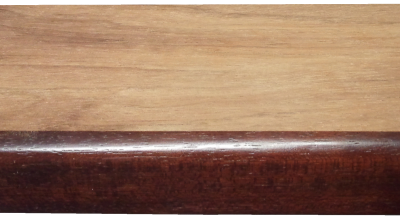
Is it weathered or have a patina?
Many woods, when left outside in the elements, tend to turn a bland gray color. Also, even interior wood also takes on a patina as it ages: some woods get darker, or redder, and some even get lighter or lose their color; but for the most part, wood tends to darken with age.
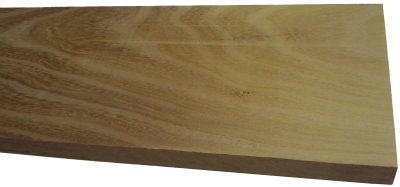
Is it possible to sand or plane the board to see the natural raw color of the wood?
The most predictable baseline to use when identifying wood is in a freshly sanded state. This eliminates the chances of a stain or natural aging skewing the color diagnosis of the wood.
3. Observe the wood grain.
If the wood is unfinished, then look at the texture of the grain. Ask yourself these questions:
Does the wood have an open, porous texture?
Most softwoods will be almost perfectly smooth with no grain indentations, while many common hardwoods have an open pore structure, such as oak or mahogany; though there are some hardwoods that are also smooth to the touch, such as maple.
Can you tell if the wood is quartersawn or plainsawn?
By observing the grain patterns, many times you can tell how the board was cut from the tree. Some wood species have dramatically different grain patterns from plainsawn to quartersawn surfaces. For instance, on their quartersawn surfaces, lacewood has large lace patterns, oak has flecks, and maple has the characteristic “butcher block” appearance.
Is there any figure or unusual characteristics, such as sapwood, curly or wild grain, burl/knots, etc.?
Some species of wood have figure that is much more common than in other species: for example, curly figure is fairly common in soft maple, and the curls are usually well-pronounced and close together. Yet when birch or cherry has a curly grain, it is more often much less pronounced, and the curls are spaced farther apart.
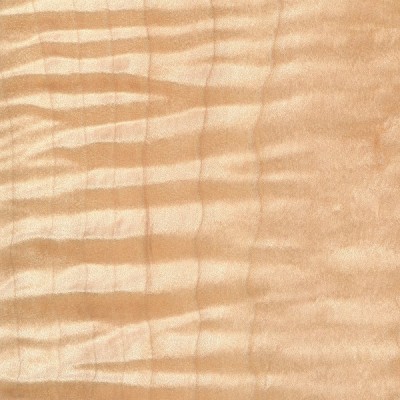
4. Consider the weight and hardness of the wood.
If it’s possible, pick the piece of wood up and get a sense of its weight, and compare it to other known wood species. Try gouging the edge with your fingernail to get a sense of its hardness. If you have a scale, you can take measurements of the length, width, and thickness of the wood, and combine them to find the density of the wood. This can be helpful to compare to other density readings found in the database. When examining the wood in question, compare it to other known wood species, and ask yourself these questions:
Is the wood dry?
Wood from freshly felled trees, or wood that has been stored in an extremely humid environment will have very high moisture contents. In some freshly sawn pieces, moisture could account for over half of the wood’s total weight! Likewise, wood that has been stored in extremely dry conditions of less than 25% relative humidity will most likely feel lighter than average.
How does the wood’s weight compare to other species?
Taking into account the size of the board, how does its weight compare to other benchmark woods? Is it heavier than oak? Is it lighter than pine? Look at the weight numbers for a few wood species that are close to yours, and get a ballpark estimate of its weight.
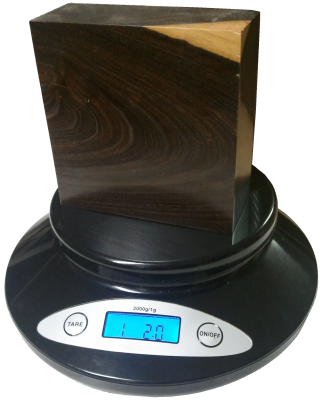
How hard is the wood?
Obviously softwoods will tend to be softer than hardwoods, but try to get a sense of how it compares to other known woods. Density and hardness are closely related, so if the wood is heavy, it will most likely be hard too. If the wood is a part of a finished item that you can’t adequately weigh, you might be able to test the hardness by gouging it in an inconspicuous area. Also, if it is used in a piece of furniture, such as a tabletop, a general idea of its hardness can be assessed by the number and depth of the gouges/dings in the piece given its age and use. A tabletop made of pine will have much deeper dents than a tabletop made of Oak. Additionally, you can always try the “fingernail test” as a rough hardness indicator: find a crisp edge of the wood, and with your fingernail try to push in as hard as you can and see if you’re able to make a dent in the wood.
5. Consider its history.
Many times we forget common sense and logic when attempting to identify wood. If you’ve got a piece of Amish furniture from Pennsylvania, chances are more likely that the wood will be made of something like black walnut or cherry, and not African wenge or jatoba. You might call it “wood profiling,” but sometimes it can pay to be a little prejudiced when it comes to wood identification. Some common-sense questions to ask yourself when trying to identify a piece of wood:
Where did it come from?
Knowing as much as you can about the source of the wood—even the smallest details—can be helpful. If the wood came from a wood pile or a lumber mill where all the pieces were from trees processed locally, then the potential species are immediately limited. If the wood came from a builder of antique furniture, or a boat-builder, or a trim carpenter: each of these occupations will tend to use certain species of woods much more often than others, making a logical guess much simpler.
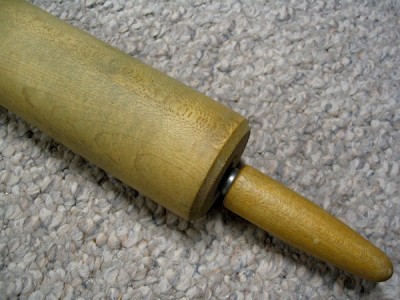
How old is it?
As with the wood’s source, its age will also help in identification purposes. Not only will it help to determine if the wood should have developed a natural patina, but it will also suggest certain species which were more prevalent at different times in history. For instance, many acoustic guitars made before the 1990s have featured Brazilian rosewood backs/sides, yet due to CITES restrictions placed upon that species, East Indian rosewood became a much more common species on newer guitars. (And this is a continuing shift as newer replacements are sought for rosewoods altogether.)
How large is the piece of wood?
Some species of trees are typically very small—some are even considered shrubs—while others get quite large. For instance, if you see a large panel or section of wood that’s entirely black, chances are it’s either painted, dyed, or stained: Gaboon ebony and related species are typically very small and very expensive.
What is the wood’s intended use?
Simply knowing what the wood was intended for—when considered in conjunction with where it came from and how old it is—can give you many clues to help identify it. In some applications, certain wood species are used much more frequently than others, so that you can make an educated guess as to the species of the wood based upon the application where it was used. For instance, in the United States: many older houses with solid hardwood floors have commonly used either red oak or hard maple; many antique furniture pieces have featured quartersawn white oak; many violins have spruce tops; many closet items used aromatic red cedar, and so forth. While it’s not a 100% guarantee, “profiling” the wood in question will help reduce the number of possible suspects, and aid in deducing the correct species.
6. Find the X-Factor.
Sometimes, after all the normal characteristics of a sample have been considered, the identity of the wood in question is still not apparent. In these instances—particularly in situations where a sample has been narrowed down to only a few possible remaining choices—it’s sometimes helpful to bring in specialized tests and other narrower means of identification.
The following techniques and recommendations don’t necessarily have a wide application in initially sorting out wood species and eliminating large swaths of wood species, but will most likely be of use only as a final step in special identification circumstances.
Odor
Believe it or not, freshly machined wood can have a very identifiable scent. When your eyes and hands can’t quite get a definitive answer, sometimes your nose can. Assuming there is no stain, finish, or preservative on or in the wood, quickly sand, saw, or otherwise machine a section of the wood in question, and take a whiff of the aroma.
Although new scents can be very difficult to express in words, many times the scent of an unknown wood may be similar to other known scents. For instance, rosewoods (Dalbergia spp.) are so named for their characteristic odor that is reminiscent of roses. Although difficult to directly communicate, with enough firsthand experience scents can become a memorable and powerful means of wood identification.
Fluorescence
While certain woods can appear basically identical to one another under normal lighting conditions, when exposed to certain wavelengths—such as those found in blacklights—the wood will absorb and emit light in a different (visible) wavelength. This phenomenon is known as fluorescence, and certain woods can be distinguished by the presence or absence of their fluorescent qualities. See the article Fluorescence: A Secret Weapon in Wood Identification for more information.
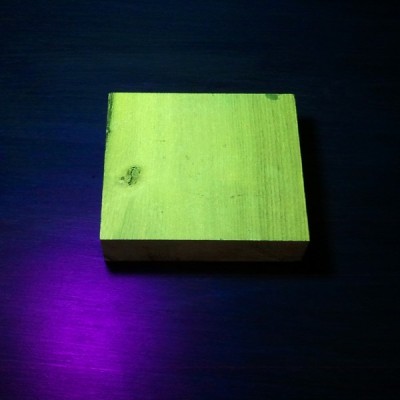
Chemical Testing
There are only a small number of chemical tests regularly used on wood, most of which are very specialized and were developed to help distinguish easily confused species with one another. They work by detecting differences in the composition of heartwood extractives. A chemical substance (called a reagent) is usually dissolved in water and applied to the wood surface: the surface is then observed for any type of chemical reaction (and accompanying color change) that may occur. Two of the most useful are the tests that are meant to separate Red and White Oak, and Red and Hard Maple.
Heartwood Extractives Leachability
Sometimes a wood species will have heartwood extractives that will be readily leachable in water and capable of conspicuously tinting a solution of water a specific color. For instance, the heartwood extractives contained in osage orange (Maclura pomifera) contain a yellowish-brown dye that is soluble in water. (This can sometimes be observed anecdotally when the wood is glued with a water-based adhesive: the glue’s squeeze-out is an unusually vibrant yellow.)
In a simple water extract color test, wood shavings are mixed with water in a vial, test tube, or other suitably small container, and the color of the water is observed after a few minutes. If the heartwood extractives are leachable by water, then a corresponding color change should quickly occur.
In addition to osage orange (Maclura pomifera), merbau (Intsia spp.), and rengas (Gluta spp. and Melanorrhoea spp.) are also noted for their readily leachable heartwood extractives. Because this property is quite uncommon, it can serve to quickly differentiate these woods from other lookalikes.
7. Look at the endgrain.
Perhaps no other technique for accurate identification of wood is as helpful and conclusive as the magnified examination of the endgrain. Frequently, it brings the identification process from a mostly intuitive, unscientific process into a predictable, repeatable, and reliable procedure.
Looking at the endgrain with a magnifier shouldn’t be a mystifying or esoteric art. In many cases, it’s nearly as simple as examining small newsprint under a magnifying glass. There are three components necessary to reap the full benefits contained in the endgrain:
I. A prepared surface.
When working with wood in most capacities, it becomes quickly apparent that endgrain surfaces are not nearly as cooperative or as easily worked as face grain surfaces. However, in this case, it is absolutely critical that a clear and refined endgrain surface is obtained.
For a quick glance of a softwood sample, a very sharp knife or razor blade can be used to take a fresh slice from the endgrain. However, in many denser species, especially in tropical hardwoods, one of the best ways to obtain a clear endgrain view is through diligent sanding. It’s usually best to begin with a relatively smooth saw cut (as from a fine-toothed miter saw blade) and proceed through the grits, starting at around 100, and working up to at least 220 or 320 grit, preferably higher for the cleanest view.
II. The right magnifier.
It need not be expensive, but whatever tool is used to view the endgrain should have adequate magnifying power. In most instances, 10x magnification is ideal, however, anything within the range of 8 to 15x magnification should be suitable for endgrain viewing. (Standard magnifying glasses are typically in the range of 2 to 4x magnification.)
These stronger magnifiers, sometimes called loupes, usually have a smaller viewing area than standard magnifying glasses. Fancier models—with built in lights, or larger viewing surfaces—are available at a premium; but the most basic models are usually only a few dollars.
III. A trained eye.
The third element that constitutes a proper endgrain examination is simply knowing what to look for. In analyzing the patterns, colors, shapes, and spacing of the various anatomical features, there is a veritable storehouse of information within the endgrain—all waiting to be unlocked. Yet, if these elements have not been pointed out and learned, the array of features will simply seem like an unintelligible jumble. The discipline of recognizing anatomical endgrain features is not easily summed up in a few sentences or even a few paragraphs, but it is nonetheless critical to the identification process. To this end, an in-depth look should be given to the various categories, divisions, and elements that constitute endgrain wood identification on the macroscopic level. (In this regard, macroscopic denotes what can be seen with a low-powered, 10x hand lens—without the aid of a microscope—rather than simply what can be seen with the naked eye.) Because the anatomy between softwoods and hardwoods is so divergent, each will be considered and examined separately:Still stumped?
If you have a mysterious piece of wood that you’d like identified, you’ve got a few options for next steps:USDA’s Forest Products Laboratory
You can mail your physical wood samples to the Center for Wood Anatomy Research.
Pros:
- Free
- Professional wood identification
Cons:
- Only available to US citizens
- Slow turnaround times (up to a month or more)
- Limited to three IDs per year
See their Wood ID Factsheet for more info.
Alden Identification Service
You can mail your physical wood samples (even small sections taken from antiques) to Alden Identification Service.
Pros:
- Professional wood identification
- Faster turnaround times (ranging from a few days to a week or two)
Cons:
- Paid service
See their ordering page for more info. (Note that Harry Alden has written several books while at USDA, including both Hardwoods and Softwoods of North America.)
Ask for help online
If the wood ID is merely a curiosity, or non-critical, you can post pictures of the wood in question.
Pros:
- Free
- No need to send physical samples
Cons:
- Greatly limited by the quality of the pictures provided
- Extra work usually required to get adequate clarity in photos
See article of Common US Hardwoods to help find the most commonly used woods.
Get the hard copy
 If you’re interested in getting all that makes The Wood Database unique distilled into a single, real-world resource, there’s the book that’s based on the website—the Amazon.com best-seller, WOOD! Identifying and Using Hundreds of Woods Worldwide. It contains many of the most popular articles found on this website, as well as hundreds of wood profiles—laid out with the same clarity and convenience of the website—packaged in a shop-friendly hardcover book.
If you’re interested in getting all that makes The Wood Database unique distilled into a single, real-world resource, there’s the book that’s based on the website—the Amazon.com best-seller, WOOD! Identifying and Using Hundreds of Woods Worldwide. It contains many of the most popular articles found on this website, as well as hundreds of wood profiles—laid out with the same clarity and convenience of the website—packaged in a shop-friendly hardcover book. 





Why I will no longer be replying to every wood ID request I’ve replied to literally thousands of wood ID requests on this site over the past 13+ years, but as the site’s popularity has grown, so has the time demands for ID on a daily basis. (Contrary to what some may seem to think, I am not some all-knowing wood wizard that can instantly ID your wood. It can actually take me a long time to sift through a lot of different resources.) Over the past few years, my backlog of pending wood species to be added to the… Read more »
Hi there
Just trying to figure out what type of wood this side table maybe? thank you
Looks like a very nice piece, portions of which are veneered. I can’t tell from the pictures. For a piece like this, I would have it professionally appraised.
looking for the wood type and stain to fix scratches. This is a bed frame. Thank you very much
I’m guessing it’s a stained softwood, but the color you’re after is a reddish cherry finish.
Hi Eric, great article. I found this chair that I am refinishing, I was wondering if you could confirm my guesses: I believe the bottom part is walnut and the side is oak, but I’m not totally sure. These photos are from it sanded clean then wiped with mineral spirits. Thanks.
Looks very strange, certainly doesn’t resemble anything common to US woodworkers. Are you in North America?
Yes, I’m in California
Here’s more photos after 2 layers of linseed oil, hope this helps.
Could you please tell me what kind of wood this is? I was thinking it might be cordia, but I’m used to seeing more waviness in the grain and less uniformity in the banding.
Looks rather unusual, hard to say for sure. If I had to limit my guesses to only commercially available hardwoods, I would say a very light piece of wenge.
one more:
Does is smell like oak when you saw it? To me, it looks closest to just some old growth oak where the growth rings are closer together (resulting in a lighter weight) and the grain pattern might not be as apparent.
Thank you for your reply. It’s really heavy and according to my husband it didn’t
smell like oak when he sawed it. There isn’t really a good look in how the pattern is cut through since the piece is rather slim and consists mainly of the core.
Hello! Me and my husband got our hands on some wood that was given away as firefuel. We saw that they had some really nice pieces of wood (oak, cherry, apple, birch etc.) so we took the pieces that looked like something useable.
We got a piece of wood that we have a really hard time identifying. Maybe you have a hunch? Would much appreciate the help!
what kind of wood is this please … thanks
It looks like stained quartersawn white oak, common in antiques. Those arched lines, even though they look like grain lines, are actually ray fleck.
Hello- I’m looking to identify this wood so that I can find complimentary nightstands to go with this piece.
It appears to be a softwood or other nondescript wood that’s been stained with a dark walnut stain.
Trying to figure out this wood, are these pics enough?
Couple more
Looks like it is veneered walnut. The center design would be walnut burl veneer.
Is this yellow pine wood, I need to replace the board the termites ate!
No, it looks like hard maple to me.
Hi….maple. we had the same ones in our house.
I have some old chairs I’m refinishing. Curious what you think they’re made of. They kind of look to be a hodge-podge of different woods. One of the stretchers has this interesting wavy grain pattern on it but I don’t see it anywhere else on any of the chairs. Curious what you think!
More pictures
And one more…
Possibly some type of figured mahogany?
In my opinion, you shouldn’t refinish those nice old pieces of furniture. I don’t know how many times I’ve heard a furniture appraiser on Antiques Road Show say “too bad it was refinished, it would be worth ten times more!”
Hello, just moved to a new home and movers lost two legs for our dining room table. Need to replace the legs, but can’t tell exactly what type of wood this is… any ideas?
Hi Eric what an interesting site. I wondered if you might be able to help in identifying this wooden table. Pretty sure it’s hardwood, it’s very heavy. I’m sure it’s stained as I can see some shallow scratches revealing a paler colour underneath. Any help appreciated! Thanks (Holly from UK)
Looks like a ring porous hardwood. Can’t tell which one, maybe ash or oak?
Any clue what type of wood this is?
Hi-can you please help me identify this wood? Thanks
Looks to be a veneered hardwood. Can’t tell which one though.
thank you for your response…do you think this could be maple? It is honey colored like it, but the grain is throwing me off.
Can you get a closer picture of the grain?
actually I see a little bit of “ribbon” in it now.
Here is a picture of the legs as well, that also have the dark streaks running through the wood.
Are you located in the US, or elsewhere? It certainly doesn’t resemble any of the commoner hardwoods seen in furniture that I know of. It looks to be a diffuse porous or semi-diffuse porous hardwood, but the pore size looks too large to be maple.
I am located in CT and it’s not a wood that I am familiar with here, so that would definitely rule out maple. Wasn’t sure if the rings were darkening with age? Thanks, I appreciate your expertise.
I would love help identifying the wood in this parlor table. I’m told it came from great grandparents in Pennsylvania, but know nothing else about it. In all my research I haven’t found anything quite like this grain. Help is appreciated!
Looks like figured tamo ash, perhaps with a light brown stain applied to accent the grain.
This is a Cane / Walking Stick from the early 1800s that has been handed down.
We are trying to identify the wood. It is fairly heavy.
Hi, I’ve been trying (and failing) to identify the inlay on this vase … hoping someone here can help please? I think the main body of the vase is Sour Cherrywood but no idea about the inlay at the top. Thanks
Looks like a lacewood type of wood. From the darkness of it, my first guess would be leopardwood.
Hi Eric,
I got a really nice antique chair (I hope it’s an antique). Can you recognize what wood type it is?
Thanks a lot!!!
It looks to be stained and not its original color so it’s kind of hard to tell. Do you have any other pictures of the grain of the wood?
This is the back side of the chair. It’s the biggest exposed area of wood. Hope this helps.
The color and grain of the second picture, especially in the upper right corner of the picture, look very much like black walnut to me.
Thanks a lot!
Any idea what the orange colored wood is?
More than likely it’s padauk.
Any ideas about this? I got it at a local store they don’t know what it is. Came waxed. A bit harder than hard maple, but not like other exotics. Medium density. Turned easily, but somewhat splintery. No distinct scent to me. I’m talking about the upper wood naturally.
Not sure what that one could be. One possbility that comes to mind is jicarillo.
Hi, I would be bery grateful for help in identifying the wood of this 500 year old frame
Thank you!
Looks like a softwood such as pine that’s been stained (or just really aged, I guess). The giveaway is in the gouges or nicks in the wood, where the wood underneath is noticeably lighter in color. If it were a naturally dark colored wood like walnut, this would not be the case.
Thank you very much. It’s an important piece of information to help tracing the author
Any idea what this wood is. Thank you
Hey all! I acquired a good stash of hardwood chunks from the new owner of a house once owned by a wood worker. I’ve identified most all but this one.
All help appreciated!
Hard to say, definitely looks like a tropical hardwood of some sort, which can be tough to ID. Perhaps a shot of the endgrain would shed more light?
Hi, professionals!
Does anyone know what is it? I guess it’s some exotic wood. Black grains are extremely hard, lighter softwood is very soft.
Thanks for any ideas!
Looks like black palm!
Dear Eric, thanks for suggestion!
I’ve checked this specie pictures in internet – yes, you’re completely right. I’ve held black palm in hand.
BR, Gleb
Pine or Cedar outside posts on a deck, newer porch addition white paint, yellowish original to the house 1950s the yellowish were wrapped with broken pine boards
Please could you help identify the main wood in the attached picture? Thank you
It is a burl wood. To me, it looks closest to thuya burl. https://www.wood-database.com/thuya/
Anyone please identify this Exotic ?
The pattern looks like snakewood to me.
Hello Eric,
Thanks for your comment, its not Snakewood, if I saw this image I would have said the same.
Can you get a picture of the endgrain?
Hi there, I have recently inherited several vintage wood serverware pieces like bowls, trays, vases, goblets etc. from my husbands grandparents who travelled a lot to Thailand and Hawaii. His dad told us some of it is Koa. Some of them have endgrain but others don’t. I know some of it is walnut, teak, monkey pod , and Hawaiian Koa. I just don’t know how to tell.. I have read several articles you wrote and I appreciate the hours you’ve put in to this. It seems that monkey pod and Koa are strikingly similar. What do you think is my… Read more »
I sanded it to 320grit, hopefully this gives you a better presentation.
First one has no finish, second one has a basic kitchen grade oil finish on it.
Zak
That’s a hardwood; looks most like Honduran mahogany to me — at least the unfinished pic does. That oil seems to add a lot of red to the wood.
Would you suggest this wood for use as a knife handle/scale?
Also, I can provide closer shots of the grain if that might help you determine the wood further.
Thanks
Zak
I don’t see why not. Mahogany is very stable and shouldn’t warp or change too much with changes in humidity. The only thing might be it’s hardness, so depending on how rough an environment it will be in, it may be more prone to dents or dings than some of the other super-hard woods used for knife scales like desert ironwood.
Hello Eric,
I added your book to my Library. Great resource!
I was wondering; Do you have any data on shear (and/or horizontal shear between grain lines)?
Thank you.
Thanks Drew, I don’t have any collected data on shear strength as it is not a commonly tested property for wood. You might look into the USDA Wood Handbook in their chapter on mechanical properties of wood for a more in-depth look at different strength properties, though there are much fewer species covered with these more specialized tests.
Accidentally pressed post without pictures.
Can’t make out too much detail. Need to sand to a higher grit, or else try cleaning up the end with a chop saw. Put the board right up to the edge of the saw and shave off just a tiny bit of wood and it will usually leave a decent surface. The patterns are there, they’re just not visible without more sanding.
Hello,
I’ve got a hold of 3 pieces of wood that I cannot identify. I’m presuming its soft wood. There is no distinct pattern showing, I tried sanding it and it still didn’t show any patterns.
The blocks I have are all about 2x4x6 and are fairly light weight.
Hi Eric – Any chance you can help with this one? This wood is from my grandfathers sea trunk when he was on the navy trip. I’m planning to make something for my family out of it but can’t identify the wood to try to match. Any ideas you might have would be greatly appreciated!!
Possibly maple?
Hi Eric,
I am thinking to change the stain of my current floorboard. But I couldnt find the exact wood type. Attached is a picture, would be able to help me identify ?
I am no expert but this looks like South American Pearwood to me.
I attached a photo of a floor that we sold a few years ago.
Hi Eric
I bought these corbels at a restore place. Any chance you can identify the wood? Thank you so much!
Hi Eric, we are confused and hope you can help. We bought this church pew and wanted to refinish it. The seat was sanded down and we stained it with “weathered oak”, but this is the result. A very red tint and no where near what we expected. Any thoughts on why? (sorry if it seems obvious or dumb, we are definitely newbies to this) The second pic is the color it was after sanding and before staining. Thank you for your time!
Hi Eric. A contractor wants to replace my oak hardwood floors with VMHS Palm Acacia 3/4 ×4 3/4 B hardwood from China ( 10038036 VMPA 5-B
12/26/2018 . Is this really oak or an oak wood equivalent.
No, not oak. More than likely a species of Acacia — of which there are hundreds of species, so it’s anyone’s guess what it is.
Hey Eric what type of wood is this.. I have a guess but i’m not 100% sure..
THX
Thank you for responding so quickly.
This photo is the underside of the table.
A few years ago the wood was sanded top and bottom due to damage during a move. Only the top received varnish.
1/8” was removed from top to remove damage. The wood remained dark. No stain was applied.
Thank you
Hi, I got this from a sawmill, but I forgot to ask what type of wood it was and was wondering if you could help me! Thank you!!!
Can you help me identify this wood?
I would need to see a closer picture of the grain (unstained/unfinished).
Thank you, interesting information.
I purchased this solid wood 60” x 60” table in 2001. The table consists of 3.5” x 4.5” planks of wood that are very dark in color with a reddish tint. The unfinished bottom shows the same. The table was approximately $10,000 in 2001, I do not know the wood type.
Can you assist with an opinion?
Thank you
Hello,
I sent the undersides of the table on July 12. I was wondering if you have an opinion?
Thank you
Dean Seymour
My opinion is that it is a dyed softwood. If you look at the picture above, you can even see the lighter wood grain on the edges. Also, on your closeup of the underside it shows the growth rings are lighter than the body of the wood, which wouldn’t be the case for dark-colored hardwoods but would occur if a softwood were dyed where the denser latewood sections don’t absorb as much of the dye.
In the process of demoing an old house in Texas built in 1920. I know the wood is old and shiplap, but is the wood cedar? Have several people inquiring as to what I am going to do with the wood, so just would like a good idea of what I have. Thanks.
Looks like southern yellow pine to me.
Hi Eric,
Great job identifying the woods.
I wonder if you can help out identify this.
I inherited my grandads grandfather clock, but I am not sure of it’s wood.
I think it could be a type of rosewood or mahaghony as it is a reddy-brown colour with distinctive very straight dark graining.
The clock dates from 1912.
Thanks in advance.
Kind regards
Paul M
Definitely looks like a a type of mahogany. Could be sapele? See this article for more info: https://www.wood-database.com/wood-articles/mahogany-mixups-the-lowdown/
Hi! Thanks for your informative post! I’m currently trying to refinish the top of an old lute guitar, but since I don’t know what kind of wood it is made from, I’m not sure if I should use a grain filler or not. Since I can’t see the end grain either, it’s kind of hard to identify. Would you mind taking a look? It seems pretty soft and non-porous, so I would guess it’s some kind of softwood.
More than likely it is spruce. No grain filler needed.
Hello,
I bought a desk and on the manufacturer’s website it said it was rosewood. They have another version of the same desk makde of acacia. I just want to know if the wood is actually rosewood and if possible, could you tell me the type of finish on it? It’s not glossy and the website said it was a sealed finish which I don’t know what it means.
I’m trying to get matching furniture, that’s why I wanna know the type of wood.
I appreciate any help.
Assuming that they are being honest in their “rosewood” designation, it could be sheesham, which is Dalbergia sissoo. The term “sealed finish” is very vague and could mean anything. Just call the sheen satin and try to match that.
Thank you for the response. I googled that and, to my non-expert eyes, it looks exactly like my desk. I don’t know if that type of wood is rare or expensive to think that it’s not actual rosewood. But the desk was made in India so I guess that further confirms it. Thanks again.
I bought a wooden bowl at a thrift store to use to make bread but, now I’m not sure it’s safe to use. It’s a very soft, very light weight, blonde wood. Do you have an idea what it might be from my description? If it’s safe material it will be a perfect bread bowl.
Do you have any pictures? There are quite a large amount of lightweight, light colored woods. Generally, I’d say that most of the times the wood itself is safe — I’d be more concerned with the finish on the wood. Also, if the wood is porous, it can harbor bacteria; all softwoods, such as pine, are non-porous, so that’s at least one positive indicator.
Small brown look dots. ?? What kind of wood?
Another pic. Old cabinets
Are they maple? What makes the dark looking spots?
Looks like oak, finished with a technique called “flyspecking.” Basically, in the 70s and 80s, furniture makers thought it would look good to take the stain that was being used on the wood and splatter it all over the wood — resulting in the “specks” on the wood. The technique has since fallen out of vogue.
I recently picked up this table top. It’s about 7 feet long, 2 inches thick, and very heavy! The grain is beautiful and I’m trying to identify the wood type. I bought it from someone in France (where I live) but it apparently originally came from Hong Kong. Any ideas?
Photos.
Looks very interesting! I don’t really have a decent guess at what it might be though. I’m guessing that those black lines are massive rays, similar to Allocasuarina species found in Australia. If you ever do find out, let us know!
Any thoughts on this?
Hello, I’m trying to identify the wood types in this sculpture(2nd half 20th century.) I think it is pine and oak, stained and painted. Does that seem right?
I picked up a chunk of fire wood and wash shocked when I cracked the piece open! It has a magnificent marbled purple and white ribbons through it. It carved very nicely, but I have no clue what the heck it is! Any help would be marvelous.
Got any pictures?
Buckeye burl?